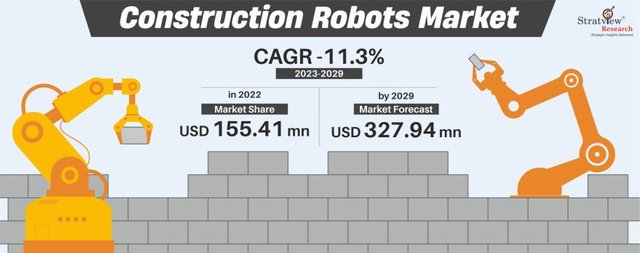Robots at Work: Transforming the Construction Industry
The construction industry is entering a new era of automation. With labor shortages, safety concerns, and the demand for speed, robots are becoming a crucial tool on job sites. Construction robots are machines designed to perform tasks such as bricklaying, excavation, and demolition—transforming how infrastructure is built.
According to Stratview Research, the construction robots market was estimated at USD 155.41 million in 2022 and is likely to grow at a CAGR of 11.3% during 2023-2029 to reach USD 327.94 million in 2029.
Download the sample report here, to uncover in-depth insights.
https://stratviewresearch.com/Request-Sample/3296/construction-robots-market.html#form
Drivers:
• Labor Shortages: Aging workers and declining interest in manual labor have pushed companies to seek robotic solutions.
• Cost and Time Pressures: Robots reduce project delays and optimize resource usage.
• Smart Cities and Urbanization: The demand for rapid, high-quality construction in cities supports robotic adoption.
Challenges:
• High Capital Costs: Investing in advanced robots is expensive for small and medium enterprises.
• Site Complexity: Construction sites vary widely, making full automation difficult.
• Skill Gap: Workers need to be retrained to work with and maintain robotic systems.
Opportunities:
• Modular and Prefabricated Construction: Robotics enables greater precision and speed off-site.
• AI and IoT Integration: Smarter robots with data capabilities can improve planning and execution.
• Developing Economies: Infrastructure booms in emerging markets are ripe for automation.
Trends:
• Use of drones for mapping and surveying
• Robotic arms for repetitive tasks like bricklaying and welding
• 3D printing for on-site housing and emergency shelters
Conclusion:
As costs decrease and technology improves, construction robots will continue to disrupt traditional processes. Companies that adapt early will benefit from greater efficiency, lower risks, and stronger competitive advantage.
